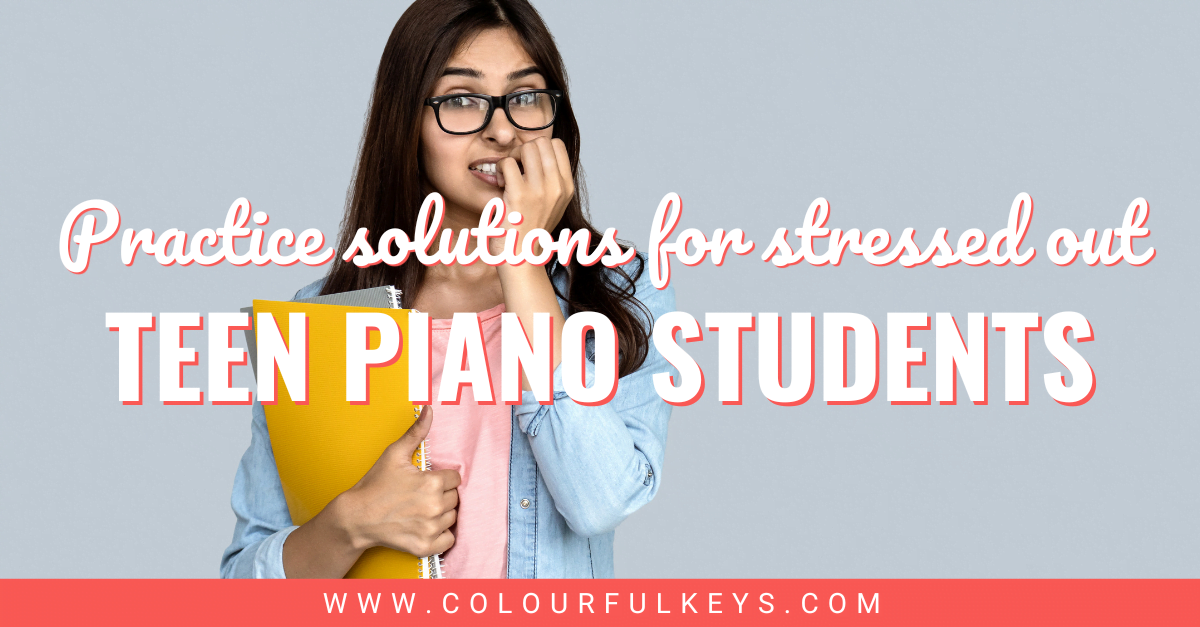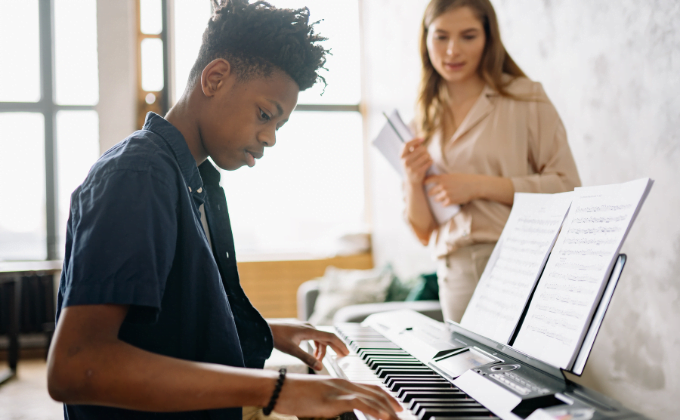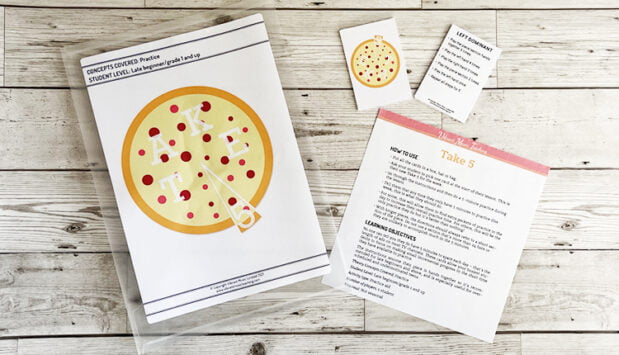
This blog post about using a “no-practice” approach to piano lessons for teens was written by Joanna Shiel. Joanna is a travelling piano teacher currently living in Bulgaria, where she teaches remotely. She has run her studio for over 13 years and hates when she has to say goodbye to teen students, even if it’s because they’re heading off to university! Check out Joanna’s studio at theonlinepianoschool.com.
Ask any piano teacher what their teen students struggle with the most, and it’ll probably be practice. What do you do when an over-scheduled teen loves their piano lessons, but is too busy and stressed out to practise at home? Do you let them just walk out the door?

With younger piano students, it’s much easier to enforce practice – a quick word with the parents and habits can be corrected. When those adorable kiddies become stressed-to-the-max teenagers, practice is a bit more complicated.
If you have a teen who is struggling to juggle everything life throws at them, it might be time to try “no-practice” piano lessons.
What are no-practice piano lessons?
Simply put, “no-practice” piano lessons take the pressure off your over-scheduled teen students having to pile piano practice on top of everything else they’re doing during the week.
It could be a short-term or a long-term measure that you implement with select students.
It doesn’t mean that students simply slack off during the week because they can’t be bothered or aren’t interested. Instead, it’s a “do what you can” approach to lessons.
The goals of no-practice piano lessons for teens:
- Provide a safe and creative space for your student to have a weekly “musical escape”
- Carry the teens through intense periods in other areas of life, such as school prep for exams or sports training
- Continue to inspire and nurture your student, and engage their brain
When is it time for “no-practice” piano lessons?
No-practice piano lessons are not meant for teens who just don’t know how to practise or who don’t practise effectively. In those cases, I encourage you to work through a few targeted practice strategies with them during lessons.
But if you have an over-scheduled teenager who isn’t making much progress, who is essentially repeating the same assignment sheet for several weeks in a row, you might want to consider a no-practice approach.
If your teen student is going to quit lessons because they simply don’t have time for home practice, this could be the perfect solution.
Communicating with Piano Parents
Start by suggesting the “no-practice” approach to the parent before ever mentioning it to the student.
If your teen student is really excited about the possibility but the parent is adamantly against it, then you’ve just turned the parent into a bad guy. 😲

When talking with parents, it’s important to communicate:
- What the no-practice approach is
- What a typical lesson looks like
- Why you think it’s the right solution for their teenager at this time
- How long you’d recommend they do no-practice lessons
- The results you’ve seen when other teenagers have gone through periods of no-practice lessons
I like to compare piano lessons to other extra-curricular activities, such as football. Students often go each week to football class without the expectation of home practice in between, and it’s still a worthwhile activity to pursue.
Bringing Everyone to the Table
No-practice lessons should be clearly defined, with expectations set and understood by all – teacher, parent and student.
First, establish the time frame. For example:
- 1 month, until Winter exams are over
- During football season from April through June
- All of the teenager’s senior year
Then, make sure that you’ve sat down with your teen to set goals for their piano learning. What does your teen hope to achieve, explore or feel by the end of this no-practice period?
What does a no-practice piano lesson look like?
Pack your teen’s no-practice lessons with quick wins and things they can build on from week to week.
Lesson Elements
Here are just a few of the many elements you could include in a successful lesson during a no-practice period:
- Physical warm-ups and exercises
- Repertoire
- Technique exercises
- Technical skills (scales, chords etc.)
- Improvisation and composition
- Music theory games from the Vibrant Music Teaching Library
- Rote pieces
- Sight reading using a book or from the appropriate level of Reading Railroad
- Rhythm activities
- Listening to new music
- Picking out a pop song by ear
Repertoire
You’ll need to decide which piece you’ll be working on from week to week. I always recommend you choose this with your teen, not for your teen. Give them a few choices and let them have a say in what they’ll be learning.

Aim for a piece that is:
- Right at or just slightly below their current skill level (this isn’t the time for a challenge or stretch piece)
- No more than 3 or 4 pages long
Then map out a general idea of how you want to teach it. For example, if the coda is particularly tricky, you might choose to focus on that for the first week, then the introductory measures the following week.
A Sample Lesson Plan
Plan to work on the piece each week in an interleaved manner, returning to the same section over and over throughout the lesson, adding just a few new lesson elements from above, while alternating with other elements in between. See the chart below for an example of an interleaved lesson.
This way of learning pieces results in greater retention, which is especially important if your teen student needs to remember it for a whole week.
Here’s an example of how to structure piano lessons for teens during a no-practice period. Adjust to suit your student’s skill level and goals, and rotate in other elements from week to week to keep things varied and comprehensive.
| Time | Activity |
| 3 minutes | Physical warm-ups with a 1-Minute Warmup Card |
| 3 minutes | Duet improvisation from Forrest Kinney’s Create First! |
| 9 minutes | Repertoire |
| 5 minutes | Music theory game |
| 3 minutes | Their current scale |
| 7 minutes | Repertoire |
| 5 minutes | Micro-composition |
| 5 minutes | Repertoire |
| 5 minutes | An activity from Rhythm in 5 |
| 3 minutes | Sidestep Solfa (or other solfa activity) |
| 5 minutes | That week’s Take 5 card |
| 2 minutes | Review and celebrate everything they did in the lesson |
The Take 5 resource (available to VMT members) provides 18 different ways you can squeeze in 5 minutes of piano practice, just in case your teen has time. Having step-by-step instructions for the full 5 minutes often eliminates the overwhelm felt by teens who have too much going on in their lives.
I like to review a new Take 5 card with my no-practice teen at each weekly lesson, then paperclip it to the front of their book. I reiterate that I do not expect them to practise if they don’t have time…but if they need a brain break from homework or if dinner’s not quite ready, the card is right there waiting for them.
The Vibrant Music Teaching membership isn’t just a collection of games. The printable resources, courses, lesson plans, teaching videos, and SO MUCH MORE make your lesson planning a breeze. Why reinvent the wheel? Check us out!
Explore the Piano
If your period of no-practice lessons is going to be relatively short, for example, 1 month, you might choose to instead do a deep-dive exploration into 1 or more areas you don’t always have time for.
You could explore:
- Arranging
- Improvisation
- Composition
- Lead sheets
- Accompaniments
The possibilities are endless!
This is a prime opportunity to explore and discover what your teen student likes.
Your teen students are likely entering a period where they start to narrow down career and study options, and having a weekly escape from those stresses can be really liberating.
When No-Practice Lessons Aren’t Working
What do you do if you notice that motivation and enthusiasm are lacking in your teens, even with no-practice piano lessons?
It might be that your student has simply outgrown piano lessons and wants to try something new. If that’s the case, this isn’t a reflection on you as a piano teacher!
Remember, you want to fill your studio with students who you enjoy teaching and who want to learn. You can’t do that if you are hanging on to students who want to move on.
What strategies do you use when your teen student just isn’t practising?
Share your teen-teaching secrets in the comments below. 🙂
Nicola has a great section about working with teens and adults on her Planning Lessons hub page. Hop on over there for more awesomeness!

Awesome podcast as usual, Continued thanks for all you do!